Rutgers Turfgrasses Prized at Baltusrol Golf Club, Host of 98th PGA Championship
Turfgrasses bred at Rutgers are widely used at golf courses, sporting fields and parks around the world

When the world’s top male golfers gather at the legendary Baltusrol Golf Club this week, they will be playing on numerous turfgrasses developed by Rutgers University.
Players will vie for the Wanamaker Trophy at the 98th PGA Championship, including Jason Day, the defending PGA champion and top-ranked golfer. The event starts today in Springfield, New Jersey, with golfers playing four rounds from Thursday through Sunday.
Mark D. Kuhns, the club’s director of grounds since 1999, said there’s a reason why Rutgers grasses play prominent roles at Baltusrol, a National Historic Landmark. They perform well for golfers, and Rutgers strives to develop grasses that resist disease, insects, heat and drought stress, he said.
“They’re always looking for better varieties, so they have a program that’s very aggressive in that regard and probably the finest research team in the country,” said Kuhns, a golf course superintendent for 40 years and former president of the Golf Course Superintendents Association of America.
Baltusrol Golf Club opened in 1895 on a sprawling expanse below Baltusrol Mountain. It has two of the USA's top 100 golf courses, the Lower and Upper, and it’s hosted 16 major golf championships. The PGA Championship is at Baltusrol for the second time.
Rutgers has a decades-long record of breeding and cultivating top-performing turfgrasses, according to Bruce B. Clarke, extension specialist in turfgrass pathology and director of Rutgers’ Center for Turfgrass Science, which is celebrating its 25th anniversary. The modern-day breeding program began in 1962.
To date, Rutgers has developed more than 400 varieties of turfgrasses and licensed them to more than 20 companies, according William A. Meyer, professor and director of turfgrass breeding at Rutgers. At least $60 million in royalties have flowed into Rutgers coffers, and most of that money has come back to the turfgrass program to enhance its research, teaching and outreach efforts.
One of the first turfgrasses bred in the United States – Raritan Velvet Bentgrass – was developed at Rutgers in 1940, Clarke said. And Rutgers scientists have traveled the world in search of promising grasses.
Baltusrol uses 10 Rutgers varieties, including several varieties of perennial ryegrass, tall fescue, Kentucky bluegrass and creeping bentgrass.

Rutgers’ L-93 creeping bentgrass is “the big one we’ve been using,” Kuhns said. The grass is used on playing and practice tees and some fairways. This fall, Baltusrol will mix Rutgers’ 007 bentgrass with several other varieties for use on greens, he said.
Rutgers turfgrasses have been used on golf courses since the 1940s, and many other venues benefit from them.
“Anywhere cool-season grasses are being grown in a sports stadium, there’s a very good possibility that it’s a Rutgers grass, maybe not the entire stadium, but part of it,” said James A. Murphy, Rutgers’ extension specialist in turfgrass management. “It’s sold all over the world.”
Along with many PGA tournaments, Rutgers turfgrasses have been or will be used at the 2020 Tokyo Olympics golf course; major league baseball parks, including Yankee Stadium; football stadiums, Super Bowls and college bowl games; World Cup soccer stadiums; Central Park in New York City; and the White House, Washington Monument and National Mall in Washington, D.C.
Rutgers turfgrasses dominate rankings in the National Turfgrass Evaluation Program (NTEP), which provides uniform standards for testing turfgrass varieties in the United States and Canada. Rutgers has the top-ranked tall fescue, perennial ryegrass, Kentucky bluegrass, fine fescue and bentgrasses for putting greens and fairways, according to Stacy A. Bonos, associate professor of turfgrass breeding at Rutgers.
In fact, when looking at the top 20 percent of the varieties in the NTEP performance rankings, all of the fine fescues and bentgrasses came from Rutgers, Bonos said. Moreover, 95 percent of the tall fescues and perennial ryegrasses and 60 percent of the Kentucky bluegrasses are also Rutgers varieties.
“Rutgers varieties have represented the majority of the top-ranked varieties in the NTEP trials for the past 30 years,” Clarke said.
In recent decades, Rutgers scientists have focused on developing low-maintenance grasses that need less water and fewer fertilizers, herbicides and pesticides.
“Drought is a big thing, so we’ve got a big program on drought tolerance,” Bonos said.
Rutgers has a greenhouse that moves back and forth on tracks over turf trials in Monmouth County, allowing researchers to shield turf from rainfall to conduct drought tolerance studies, Meyer said. It closes whenever rain is imminent. Recently, the greenhouse had about 3,000 tall fescue plants from many areas, and they’d been without water for about 75 days. The most drought-tolerant plants subsequently will be exposed to more humidity and disease to pinpoint the best ones.
Clarke stressed that the Rutgers turfgrass program is a team effort and the center’s 25 faculty and staff members work very well together and with the turfgrass industry.
“Everybody wants to be a member of a winning team and this is one of the best turfgrass programs in the country,” he said.
For more information, please contact science communicator Todd B. Bates at 848-932-0550 or tbates@ucm.rutgers.edu.